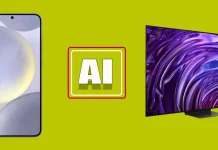If you want to connect your laptop or PC to your TV using high-speed HDMI or DisplayPort ports, you should know the following: It is quite possible and easy to implement. The only nuance is that the TV only has HDMI ports, while the laptop can have both HDMI and DisplayPort. The only thing you need is to buy a suitable cable, HDMI to HDMI or DisplayPort to HDMI.
Options for connecting your laptop to your TV
HDMI to HDMI: With this configuration, all you need to do is buy an HDMI to HDMI cable, choose the right cable length and supported HDMI version; of course, it’s best to buy an HDMI 2.1 cable
DisplayPort to HDMI TV: There is no problem with this either; DisplayPort lost the battle for the consumer segment and switched to more professional use. Accordingly, since 2015, almost all devices with DisplayPort ports have been equipped with DisplayPort ++. The two pluses in DisplayPort mean that the port also supports the HDMI standard and automatically switches the transmitted protocol depending on the received device. Buy a DisplayPort cable to HDMI.
Obsolete DisplayPort to HDMI: If your laptop does not have HDMI ports and DisplayPort does not support automatic conversion to HDMI format, you need to buy a DisplayPort to HDMI adapter with a chip that will convert the signal.
Why TVs don’t have DisplayPort
The main reason for TVs’ lack of DisplayPort is that HDMI has become the standard for the consumer market, while DisplayPort is mainly used in more specialized high-end devices.
- Manufacturing Costs: DisplayPort is more expensive to manufacture than HDMI because it supports dual encoding, which makes it compatible with HDMI. This dual compatibility requires additional components, such as two chips, which increases manufacturing costs.
- Royalties: HDMI and DisplayPort technologies require manufacturers to pay royalties. However, the difference in cost is minimal:
- Royalties for HDMI: According to Wikipedia, manufacturers pay 15 cents per device for HDMI. Interestingly, if a manufacturer advertises a device with HDMI, they can get a discount by reducing the royalty to just 4 cents per device.
- Royalty for DisplayPort: The royalty is slightly higher at 20 cents per device for DisplayPort-equipped devices.
In summary, HDMI dominates the consumer market due to its low cost and widespread adoption. In comparison, DisplayPort remains a niche choice for professional solutions, and its advanced features justify its higher cost.
Outputting Video to a TV from a Laptop via USB-C or Thunderbolt
While most laptops come equipped with HDMI or DisplayPort outputs, connecting your laptop to a TV is possible using a USB-C or Thunderbolt port. However, the ability to do this depends on the protocols the laptop manufacturer implements in the USB-C or Thunderbolt port (note that the latest versions of Thunderbolt use the USB-C port).
You can directly output video to your TV if your laptop supports alternative modes, such as HDMI. However, there is a limitation: USB-C typically supports HDMI 1.4b, which means you can only display video at a maximum resolution of 4K at 30Hz. If you need to output 4K at 60Hz, this option won’t suffice.
Here are your two options:
- Direct USB-C (Thunderbolt) to HDMI Connection: If your laptop supports the alternative data transfer protocol, purchase a USB-C to HDMI cable. This lets you connect your TV directly to the laptop’s USB-C port for video output.
- USB-C to HDMI Adapter: If your laptop does not support the alternate mode, you must buy a USB-C to HDMI adapter. This device converts the video signal from USB-C to HDMI, enabling you to connect your laptop to the TV.








